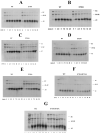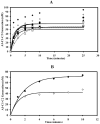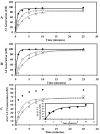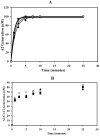Acidic residues C-terminal to the A2 domain facilitate thrombin-catalyzed activation of factor VIII
- PMID: 18642885
- PMCID: PMC2600807
- DOI: 10.1021/bi8007824
Acidic residues C-terminal to the A2 domain facilitate thrombin-catalyzed activation of factor VIII
Abstract
Factor VIII is activated by thrombin through proteolysis at Arg740, Arg372, and Arg1689. One region implicated in this exosite-dependent interaction is the factor VIII a2 segment (residues 711-740) separating the A2 and B domains. Residues 717-725 (DYYEDSYED) within this region consist of five acidic residues and three sulfo-Tyr residues, thus representing a high density of negative charge potential. The contributions of these residues to thrombin-catalyzed activation of factor VIII were assessed following mutagenesis of acidic residues to Ala or Tyr residues to Phe and expression and purification of the B-domainless proteins from stable-expressing cell lines. All mutations showed reduced specific activity from approximately 30% to approximately 70% of the wild-type value. While replacement of the Tyr residues showed little, if any, effect on rates of thrombin-catalyzed proteolysis of factor VIII and consequent activation, the acidic to Ala mutations Glu720Ala, Asp721Ala, Glu724Ala, and Asp725Ala showed decreased rates of proteolysis at each of the three P1 residues. Mutations at residues Glu724 and Asp725 were most affected with double mutations at these sites showing approximately 10-fold and approximately 30-fold reduced rates of cleavage at Arg372 and Arg1689, respectively. Factor VIII activation profiles paralleled the results assessing rates of proteolysis. Kinetic analyses revealed these mutations minimally affected apparent V max for thrombin-catalyzed cleavage but variably increased the K m for procofactor up to 7-fold, suggesting the latter parameter was dominant in reducing catalytic efficiency. These results suggest that residues Glu720, Asp721, Glu724, and Asp725 likely constitute an exosite-interactive region in factor VIII facilitating cleavages for procofactor activation.
Figures








Similar articles
-
Proteolysis at Arg740 facilitates subsequent bond cleavages during thrombin-catalyzed activation of factor VIII.J Biol Chem. 2007 Aug 31;282(35):25367-75. doi: 10.1074/jbc.M703433200. Epub 2007 Jun 26. J Biol Chem. 2007. PMID: 17595160
-
Exosite-interactive regions in the A1 and A2 domains of factor VIII facilitate thrombin-catalyzed cleavage of heavy chain.J Biol Chem. 2005 May 6;280(18):18476-87. doi: 10.1074/jbc.M412778200. Epub 2005 Mar 3. J Biol Chem. 2005. PMID: 15746105
-
Cleavage at Arg-1689 influences heavy chain cleavages during thrombin-catalyzed activation of factor VIII.J Biol Chem. 2009 Apr 24;284(17):11080-9. doi: 10.1074/jbc.M900234200. Epub 2009 Feb 24. J Biol Chem. 2009. PMID: 19240027 Free PMC article.
-
Activation of factor VIII and mechanisms of cofactor action.Blood Rev. 2004 Mar;18(1):1-15. doi: 10.1016/s0268-960x(03)00025-0. Blood Rev. 2004. PMID: 14684146 Review.
-
Factor VIII structure and function.Int J Hematol. 2006 Feb;83(2):103-8. doi: 10.1532/IJH97.05113. Int J Hematol. 2006. PMID: 16513527 Review.
Cited by
-
Turoctocog alfa (NovoEight®)--from design to clinical proof of concept.Eur J Haematol. 2014 Nov;93(5):369-76. doi: 10.1111/ejh.12366. Epub 2014 May 28. Eur J Haematol. 2014. PMID: 24797664 Free PMC article. Review.
-
Blood coagulation factors V and VIII: Molecular Mechanisms of Procofactor Activation.J Coagul Disord. 2010 Jul 1;2(2):19-27. J Coagul Disord. 2010. PMID: 21165149 Free PMC article.
-
Molecular Diagnosis of Hemophilia A and Pathogenesis of Novel F8 Variants in Shanxi, China.Glob Med Genet. 2023 Sep 13;10(3):247-262. doi: 10.1055/s-0043-1774322. eCollection 2023 Sep. Glob Med Genet. 2023. PMID: 37711502 Free PMC article.
-
The molecular basis of factor V and VIII procofactor activation.J Thromb Haemost. 2009 Dec;7(12):1951-61. doi: 10.1111/j.1538-7836.2009.03622.x. Epub 2009 Sep 18. J Thromb Haemost. 2009. PMID: 19765210 Free PMC article. Review.
-
Structural basis of thrombin-mediated factor V activation: the Glu666-Glu672 sequence is critical for processing at the heavy chain-B domain junction.Blood. 2011 Jun 30;117(26):7164-73. doi: 10.1182/blood-2010-10-315309. Epub 2011 May 9. Blood. 2011. PMID: 21555742 Free PMC article.
References
-
- Wood WI, Capon DJ, Simonsen CC, Eaton DL, Gitschier J, Keyt B, Seeburg PH, Smith DH, Hollingshead P, Wion KL. Expression of Active Human Factor VIII from Recombinant DNA Clones. Nature. 1984;312:330–337. - PubMed
-
- Vehar GA, Keyt B, Eaton D, Rodriguez H, O'Brien DP, Rotblat F, Oppermann H, Keck R, Wood WI, Harkins RN. Structure of Human Factor VIII. Nature. 1984;312:337–342. - PubMed
-
- Fay PJ. Activation of Factor VIII and Mechanisms of Cofactor Action. Blood Rev. 2004;18:1–15. - PubMed
-
- Mann KG, Nesheim ME, Church WR, Haley P, Krishnaswamy S. Surface-Dependent Reactions of the Vitamin K-Dependent Enzyme Complexes. Blood. 1990;76:1–16. - PubMed
-
- Eaton D, Rodriguez H, Vehar GA. Proteolytic Processing of Human Factor VIII. Correlation of Specific Cleavages by Thrombin, Factor Xa, and Activated Protein C with Activation and Inactivation of Factor VIII Coagulant Activity. Biochemistry. 1986;25:505–512. - PubMed
Publication types
MeSH terms
Substances
Grants and funding
LinkOut - more resources
Full Text Sources
Other Literature Sources

